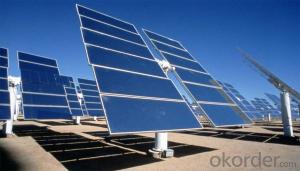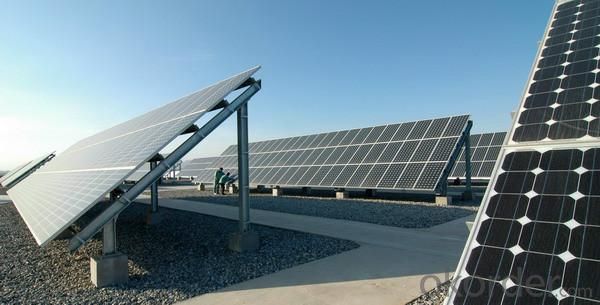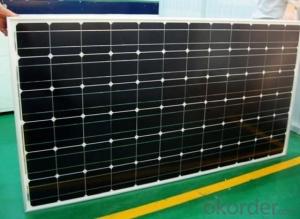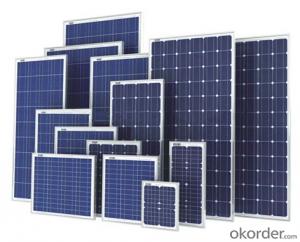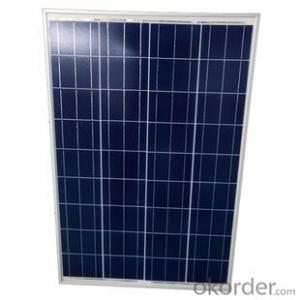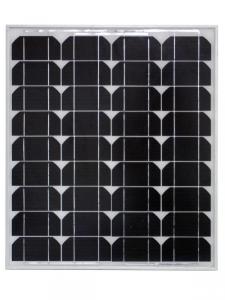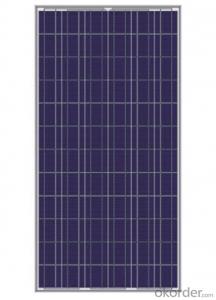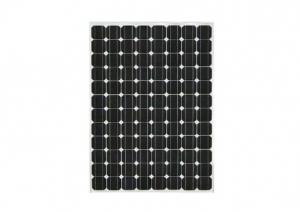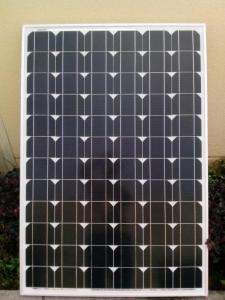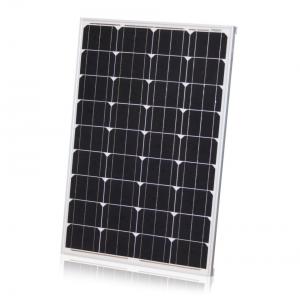Top Rated Solar Monocrystalline Panel, Portable Solar Energy
- Loading Port:
- China main port
- Payment Terms:
- TT OR LC
- Min Order Qty:
- 10000 watt
- Supply Capability:
- 100000000 watt/month
OKorder Service Pledge
OKorder Financial Service
You Might Also Like
Specification
Production description
Monocrystalline Silicon Solar Panel (60-65W)
• 10 years 90% output warranty
• 20 years 80% output warranty
• High conversion efficiency mono/poly-crystalline amorphous silicon solar cells
• Modules incorporate high performance bypass diodes to minimize the power drop caused by shading
• High transmittance, low-iron tempered glass
• High performance EVA encapsulate to prevent destroying and water.
• AI frame: without screw, corner connection. 8 holes on the frame can be installed easily
• Good performance of preventing from atrocious weather such as wind and hails
• Certifications: CE IEC TUV VDE UL, Class I
Details
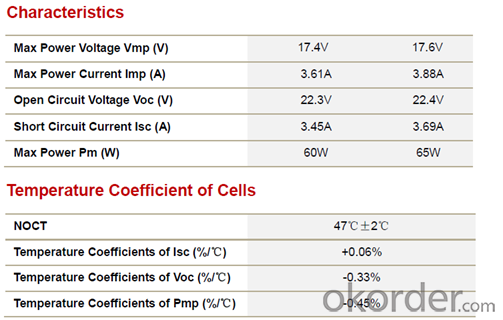
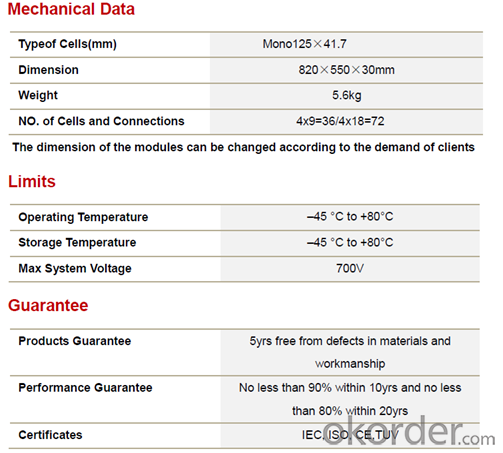

Images
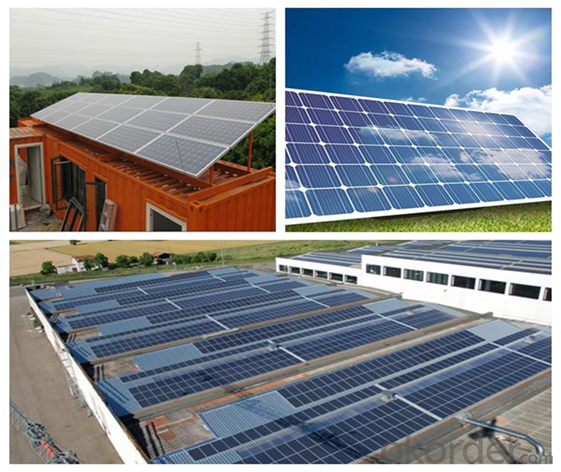
FAQ
We have organized several common questions for our clients,may help you sincerely:
1.What price for each watt?
It depends on the quantity, delivery date and payment terms,
2.How do you pack your products?
We have rich experience on how to pack the panels to make sure the safety on shipment when it arrives at the destination.
- Q: I want to know how you can store energy using a solar panel. The energy stored needs to be stored so that a light or laptop charger can plug in to it.
- Rechargable Battaries. You can get a wide range of them- which one you should use is depends on the capacity of your solar panel.
- Q: what is a solar panel?
- The term solar panel is best applied to a flat solar thermal collector, such as a solar hot water or air panel used to heat water, air, or otherwise collect solar thermal energy. But 'solar panel' may also refer to a photovoltaic module which is an assembly of solar cells used to generate electricity. In all cases, the panels are typically flat, and are available in various heights and widths. An array is an assembly of solar-thermal panels or photovoltaic (PV) modules; the panels can be connected either in parallel or series depending upon the design objective. Solar panels typically find use in residential, commercial, institutional, and light industrial applications. Solar-thermal panels saw widespread use in Florida and California until the 920's when tank-type water heaters replaced them. A thriving manufacturing business died seemingly overnight. However, solar-thermal panels are still in production, and are common in portions of the world where energy costs, and solar energy availability, are high. Recently there has been a surge toward large scale production of PV modules. In parts of the world with significantly high insolation levels, PV output and their economics are enhanced. PV modules are the primary component of most small-scale solar-electric power generating facilities. Larger facilities, such as solar power plants typically contain an array of reflectors (concentrators), a receiver, and a thermodynamic power cycle, and thus use solar-thermal rather than PV. You could get more information from the link below...
- Q: we are trying to reduce a solar panel from 9 volts to 3 volts. What do we need to make this work...
- Solar panels generate DC power. Changing DC voltage is hard, which is why the power grid is AC voltage. AC voltage can easily be changed with a transformer. To keep the DC power (watts) the same at a lower voltage you need a DC to DC converter. That basically changes the power to AC with an inverter, changes the AC voltage to the new value, then rectifies it back to DC. It is probably hard to find a commercial unit that handles those voltages and then it will be expensive. But I have a simple solution in the special case of a solar panel. Solar panels are made up of smaller solar cells. The basic solar cell has a very low voltage, like half a volt. The panel has many of them connected in series to make a higher voltage. Just cover (shade) some of them and the voltage generated by the panel will be less. Of course that reduces the power. And you may need to experiment with shading different parts of the panel and measuring the result with volt meter.
- Q: We want make solar panel for our home use. but we have no any right idea how we can make it. we want to make it with cheap prices.we also want to know the proper size of solar panel.where we can take help about making a solar panel
- How to Make a Solar Panel – Everything You are Going to Need There are several things you’re going to need when making a homemade solar panel, some of the main components include: Solar Cells Wood Plate Soldering Iron Solder Tabbing Don’t worry; special tools are not required for this DIY ‘solar panel’ project, and you will probably have everything you need laying around the garage. Now let’s go over the recommended materials for a basic solar system: Plexiglas Solar Cells Screws Lumber Jones Plug Wire Diode Caulk Silicon Material
- Q: I want to add solar panels to my home. I was looking online and it seems there are so many different kinds! How does it hook up to the electrical grid? How much do I need for a 2000 sf home?
- There are different solar panels for different uses For a domestic home it all depends on how much electricity you are going to use per month or per year For a normal use home (2 adults, 2 children) I presume one need to install a panels that would produce about4 to 5000 Kilo wats of energy per year Based on the type and the out put of the panels the suppler and the person who is advising you will guide you how many panels you will be requiring to install Take a professional help They are better informed and also knowledgeable
- Q: Can solar panels be used for powering a farm or agricultural operation?
- Yes, solar panels can definitely be used to power a farm or agricultural operation. Solar energy can be harnessed to generate electricity, which can then be used to power various farm activities such as irrigation systems, lighting, machinery, and other electrical needs. By utilizing solar panels, farmers can reduce their dependence on traditional energy sources, lower their operating costs, and promote sustainability in their operations.
- Q: My Grandfather just purchased a cheap solar panel kit for his ranch that could not muster enough power to run his mini fridge.He has two 6 volt batteries running positive to negative and would like to add more batteries. Probably 2volt. How would he go about hooking up the other batteries and what kind of wire or coil should he use.Also, I saw on youtube a guy recommending a lead-acid battery from walmart for under $20. I was just going to go to ecology and just pick up some used batteries but I may be wrong.Any help for a first timer might help me and my gramps out will be appreciated.Thank you
- If he is going to be running off batteries at night, he would be better off with traction batteries. Traction batteries are true deep cycle and can better withstand deep discharge. Golf cart batteries at Sam's Club (the other half of Walmart) are traction batteries. If your grandfather needs safe refrigeration, a mini fridge won't do it. A 0 fridge takes too much power to run off solar panels and most won't hold their cold very well if unplugged for long. I run a fridge off grid with hybrid deep cycle marine starting batteries. It's an Engel 40. The price has gone up over $00 since I bought mine. It's a real fridge with a compressor and freon 34a. But it runs on 2v dc or 0vac and only uses 36 watts running because of a special compressor design. It will freeze food if you turn the dial down to 2 out of 5. It can also deep freeze. I use mine to keep eggs, milk, cheese and fruit juice. Your grandfather would need 400 amp-hours name plate rating of batteries at 2v to run the Engel, and probably 00 real watts of panels to recharge his battery bank. The Harbor Freight 45 watt panel set only puts out 30 watts on a clear cool day. That won't do it.
- Q: How do I clean my solar panels?
- To clean your solar panels, start by checking the manufacturer's instructions as some panels may have specific cleaning requirements. Generally, you can clean them by gently rinsing with water using a hose or a bucket and sponge. Avoid using abrasive materials or harsh chemicals that could damage the panels. If there's stubborn dirt or debris, you can use a mild soap solution with a soft brush to gently scrub the surface. Regularly cleaning your solar panels will help to maintain their efficiency and ensure optimal energy production.
- Q: why don't we take a cue from mother nature and make our soar panels like trees? thousands of leaves or needle (like a pine tree) instead of one big flat panel? I mean it seems to work pretty good for all the plants i see why would it not work for us. It would be aesthetically pleasing and with the right engineering wouldn't it make them not have to worry about tracking the sun? i already have some ideas about the process of making them just no available labratory.
- Because we and the trees are trying to solve a different problem. We want electricity, a tree wants light (and some heat) for photosynthesis. In getting the electricity we use Silicon for solar panels. (Sometimes Gallium Arsenide). And we exploit the same thing in Silicon that allows them to be computer chips. The fact that they conduct differently when voltage is applied. But for a solar panel that is done essentially in reverse. We GET a voltage difference (electricity) from shoving energy through it. Look up junction bias on google or yahoo for explanation. But the DESIGN problem is: You have to couple these panels together the right way - according to their bias. You can't string them up willy nilly. There is a pattern. And when one breaks in this pattern. (I mean when the actual panel cracks, which they do easily as they are brittle). It can change the overall bias. This can make even be worse than if it was removed, it can actually fight against the working ones. The efficiency is there in arranging them like a tree, but the practicality of maintenance would be daunting.
- Q: How do solar panels affect the property's overall sustainability?
- Solar panels can significantly improve a property's overall sustainability by harnessing clean, renewable energy from the sun. By generating electricity without emitting harmful greenhouse gases, solar panels reduce the property's carbon footprint and help combat climate change. Additionally, solar panels can lower energy bills, increase energy independence, and potentially provide a source of income through net metering or selling excess electricity back to the grid.
Send your message to us
Top Rated Solar Monocrystalline Panel, Portable Solar Energy
- Loading Port:
- China main port
- Payment Terms:
- TT OR LC
- Min Order Qty:
- 10000 watt
- Supply Capability:
- 100000000 watt/month
OKorder Service Pledge
OKorder Financial Service
Similar products
Hot products
Hot Searches
Related keywords
